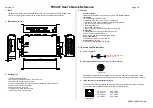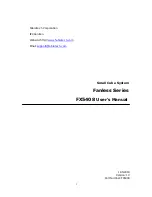
Motorized Labjack
Page 37
ETN041703-D03
When the system is powered up, the position counters in the controller are all set to
zero and consequently, the system has no way of knowing the position of the stage in
relation to any physical datum.
A datum can be established by sending all the motors to their ‘Home’ positions. The
‘Home’ position is set during manufacture and is determined by driving the motor until
the negative limit switch is reached and then driving positively a fixed distance (zero
offset). When at the Home position, the counters are reset to zero thereby establishing
a fixed datum that can be found even after the system has been switched off.
See Section 6.3. for details on performing a Home move.
C.2.3 Limit Switches
A linear stage moves between two stops, and movement outside these limits is
physically impossible. Linear stages can include stages that control the angle of a
platform within a certain range, although the movement of the platform is not really
linear but angular. Rotary stages can rotate indefinitely, like a wheel.
Linear and rotary stages both contain microswitches that detect certain positions of the
stage, but they differ in the way these switches are used.
All linear stages have a –ve limit switch, to prevent the stage from accidentally being
moved too far in the –ve direction. Once this switch is activated, movement stops. The
switch also provides a physical datum used to find the Home position. Some linear
stages and actuators also have a +ve limit switch , whereas others rely on a physical
stop to halt the motion in the positive direction. A rotary stage has only one switch,
used to provide a datum so that the Home position can be found. Movement is allowed
right through the switch position in either direction.
Fig. C.3 Stage limit switches
Rotary stage
Linear stage
Datum switch
-ve limit switch
+ve limit switch
(or stop)







































